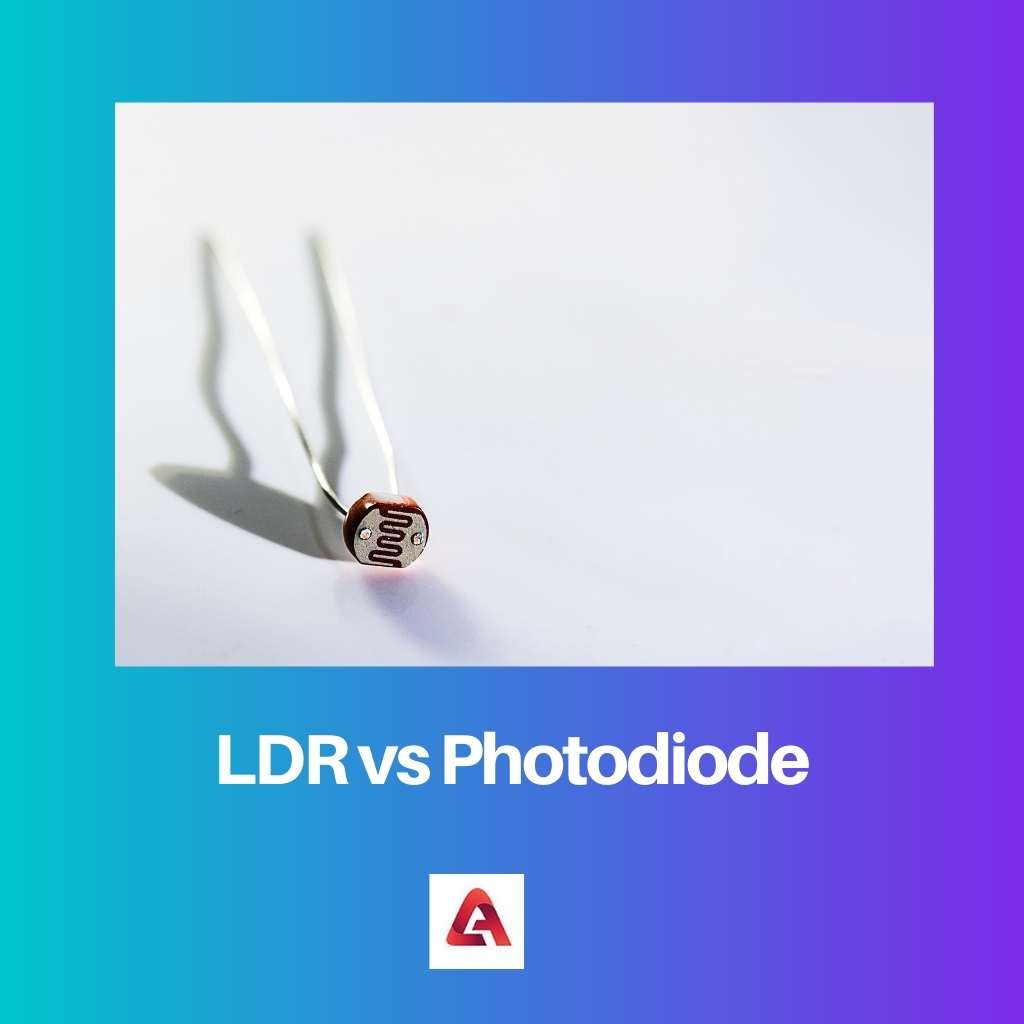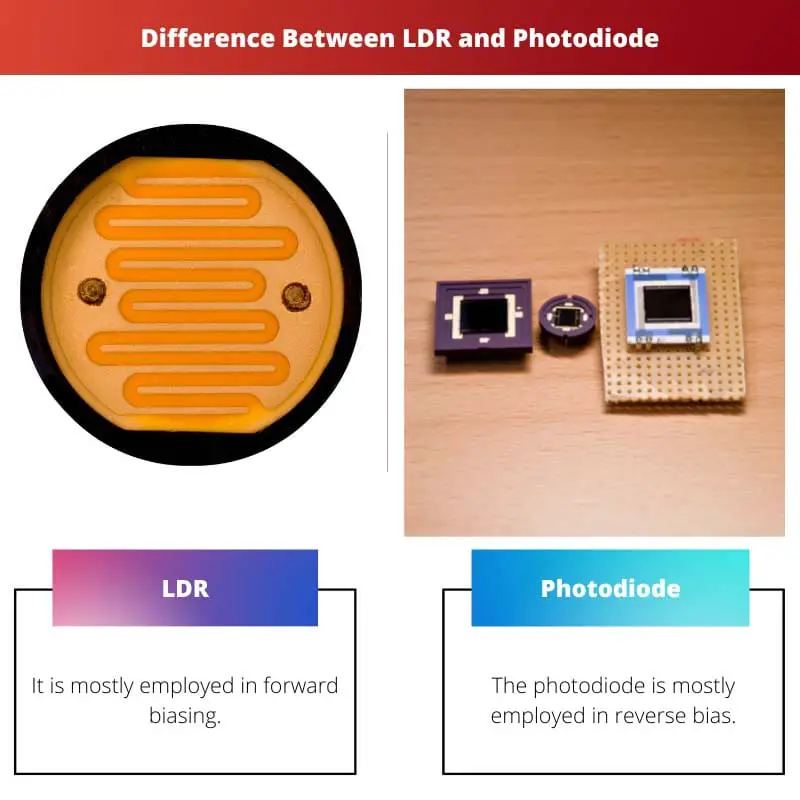Light sensors, also known as photosensors, are among the most used detectors in electrical applications. They are being used to control the amount of light.
One of the 7 fundamental physical characteristics is light intensity. The intensity of light monitoring is used in a variety of consumer, commercial, including practical points of view.
Key Takeaways
- Light-dependent resistors (LDRs) are passive components whose resistance changes with light intensity, while photodiodes are semiconductor devices that convert light into electrical current.
- LDRs are simpler and more affordable than photodiodes but exhibit slower response times and less sensitivity.
- Photodiodes offer a linear response, accurate light detection, and quicker response times, making them suitable for high-speed applications and precise measurements.
LDR vs Photodiode
A Light Dependent Resistor (LDR) is a type of passive electronic component that changes its resistance in response to changes in the intensity of light. A photodiode is also a semiconductor device that is used for light sensing, but it works by converting light energy into an electrical signal.

An LDR referred to as a photoresistor, photodetector, or photoconductor, is just a light-dependent device.
It’s a form of resistor wherein resistance completely depends on how much light hits its body.
These resistors are commonly employed in many circuits that need the detection of light.
A photodiode is just a p–n junction semiconductors system that converts light energy into electrical energy. When radiation is absorbed inside the photodiode, electricity is created.
As the total area of a photodiode rises, the system response slows. A wide area photodiode is the most popular type of solar cell being used to create electrical solar power.
Comparison Table
| Parameters of Comparison | LDR | Photodiode |
|---|---|---|
| Biasing | It is mostly employed in forward biasing. | Unlike the LDR, which is used to detect fluctuating light levels, the photodiode is mostly employed in reverse bias, shutting off when a particular illuminance is reached. |
| Application and Uses | The most widely incorporated photo sensor is a Light Dependent Resistor. | Whereas, Photodiodes are utilized in various applications that only have 2 alternatives: on or off. |
| Directionality of Resistor | A Light Dependent Resistor is a bi-directional resistor. | On the other hand, a photodiode is a unidirectional resistor. |
| Better Response Time | Since LDR is analog in nature, its response time is quite slow. | Whereas, Photodiode’s response time is pretty good when compared to its peer. |
| Examples and Instances | Street lamps are a demonstration of LDR still being used. | Whereas, precision devices, such as laboratory gadgets, such as spectrometers, are representations of photodiodes in use. |
What is LDR?
Throughout most processes that involve the need for a photosensor, the Light Dependent Resistor (LDR) is among the most extensively used and desired photoresistors.
Its most appealing feature is that it is both inexpensive and durable.
In addition, as the name implies, the light intensity beaming on them affects their susceptibility to electricity.
As a result, the amount of light they absorb has an inverse relationship with their resistance.
As a result, LDR photosensors are recommended when a variable quantity of illumination is expected rather than a constant intensity of light.
When a tough build is needed, the LDR is perhaps the sensor of choice.
This is particularly true whenever the sensor is used in a harsh and demanding environment. LDR has modest responsiveness and is also beneficial because it is a bidirectional resistance.
Both LDR (Light Dependent Resistor), as well as photodiodes are indeed the two primary categories of photosensors.
What is Photodiode?
The photodiode has a rapid response time by itself. Thus if your construction requires quick replies, this is the photodiode to choose.
The photodiode, like the LDR, is quite inexpensive. Unlike the LDR, which is then used to detect fluctuating light levels, the photodiode is mostly employed in reverse bias, shutting off because particular light intensity is surpassed.\
This indicates that now the photodiode offers two distinct current outputs. Whenever the light intensity is surpassed, it turns off; when the illuminance is adequate, it turns on.
In circumstances where it is necessary to keep track of light intensity, the photodiode is thus preferable.
Photodiodes are comparable to conventional semiconductor diodes, with the exception that they can be uncovered (to monitor vacuum UV or X-rays) or bundled with glass or optical fiber connections that allows light to penetrate the responsive component of the device.
To enhance the ability to respond, many diodes made specifically to be used as a photodiode use a PIN connection instead of a p–n junction.

Main Differences Between LDR and Photodiode
- Photosensors such as LDR as well as photodiode are broadly applied, with LDR being the most popular. It’s a light-dependent resistor that’s utilized in street lighting.
- It is also the photosensor of choice. The photodiode is applied in areas where there are just two options: on or off.
- In comparison to the LDR that is a light-dependent resistor, the photodiode has a faster reaction. It’s employed in a variety of undertakings. The photodiode is applied in accuracy gear, such as lab equipment spectrometers, and has a better response.
- When the light situation varies, the resistance of the LDR varies, and the voltage all across the photodiode shifts. Also, Silicon and Germanium are commonly used in photodiodes.
- A light-dependent resistor (LDR) is a resistor wherein resistance reduces as the intensity of light increases. Anode, as well as Cathode, are the two endpoints of a photodiode. This diode is employed in reverse bias, as well as the current flowing through it is determined by the amount of light that falls on its interface.
- Cadmium Sulphide is used to make LDR, which also has a resistance of up to 1 Mega ohm under dark settings. LDRs are low-cost and also have a wide spectrum of uses, including camera light meters, watches, blinky lights, and solar lamp posts, among others. When light strikes on a photodiode, it generates energy; ancient solar panels are nothing more than a huge photodiode. Optical disk players, smoke alarms, and television receivers are just a few examples.

- https://ieeexplore.ieee.org/abstract/document/9435280
- https://onlinelibrary.wiley.com/doi/abs/10.1002/adma.201502996

The topic about the light sensors was very informative and the differences between the LDR and the photodiode were well explained. The different uses for both kinds of sensors were interesting
Yes, the high-speed applications of photodiodes were very interesting. Good article!
I never realized the uses for both the LDR and photodiode until I read this post. Thank you!